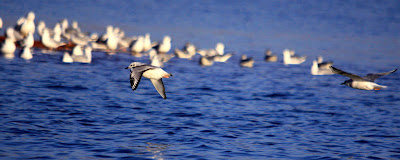 | ||
| Boaters friend |
Douglas Lake is fed by the French Broad, Nolichucky, and Pigeon Rivers, Out of the three; the Nolichucky holds the most interest to me. It is a very long river with fast water and known for it's river rafting and other sports. It may actually even have some quiet stretches of water suitable for sensible canoeing. I don't know at this point.
 | |
| Whack one of these and it's straight to the bottom |
 |
| Wonder why TVA never quarried rock out of this lake. There's a fortune to be made. |
I still don't see the need to draw this lake down as far as they do. It would take an epic Noah's Arc event to fill it; and then it wouldn't matter anyhow. Every dam in the string would overflow. For something that bad to happen; the entire Eastern United States would have to be under water. I think it's drawn down due to liability issues and I'd bet the government is that issue. Oh well, I'm off to the mud hole for new adventures. At least the Smoky Mountains can be viewed from Douglas Lake. It's window dressing but it's something.
I'll pull the boat out of here on the last day and I'll drive away and won't look back. My thoughts that day will be on when I can get back up to Calderwood Lake for a camp out.
There wasn't a fishing boat in sight on this side of the bay. I noticed Gulls by the hundreds flocking over the water, diving in and catching minnows. It appeared to be a feeding frenzy. You can bet that Striped Bass are directly under them chasing Shad which in turn disturbed the minnows and sent them scurrying in all directions. The ones that swam toward the surface would meet the Gulls and their hungry mouths.
They would just float about waiting until the minnows appeared below them.
Their wing beats were thunderous as they took flight in unison.
They would fly above and close to the surface as if they knew the exact time that the minnow lunches would be served. None dove into the water at this point.
All of a sudden, in unison, they dove into the water to grab their meals. Many would surface and sit on top the water while they swallowed their meals. Some would not take flight but would plunge their heads under water to grab passing fish, forgoing the effort of flight.
I am amazed that they don't fly into each other.
Gulls are graceful birds when they are gliding about enjoying the wind. They can really turn on the speed when they need to.
 |
| Bonaparte's Gull |
The bird below is really turning on the power. His wings are extended so far forward to grab the air that he's covered up his head.
The Gulls appear to be diving on the neighborhood.
Alfred Hitchcock could have used these scenes in his movie "The Birds."
I spun the boat around to cross the bay and follow the opposite shore back when I saw an old friend.
Definitely enlarge this shot. This is the Common Loon. They are the most challenging bird I have ever come upon to photograph. They are professionals at keeping themselves just out of photography range. The above shot is probably the best picture I have ever taken of a Loon. I'm on the water a lot and I have tried often to get good pictures of these birds but have failed. They dive and swim under water for up to three hundred feet and surface in the most unexpected places. I've seen them dive and disappear. Loons normally migrate in the Winter but some stay here on these lakes. The Loon above is sporting his Winter's plumage. An interesting thing about Loons that many folks don't know is that their legs are placed very far back on their bodies making walking on land almost impossible. Very large and old Loons even have trouble getting airborne from the water at times. It's an interesting bird.
We caught up with two fishing boats and got to see three really nice Striped Bass the weighed about 20 pounds each. Falcor was continually coming up to me and looking at my face. Yep; he had to go. We would beach on an island that I knew was safe. My legs needed some unwinding any way.
 | |
| Nope; it's not a Gull. Guess again. |




















No comments :
Post a Comment
I appreciate your interest in my blog and welcome your comments